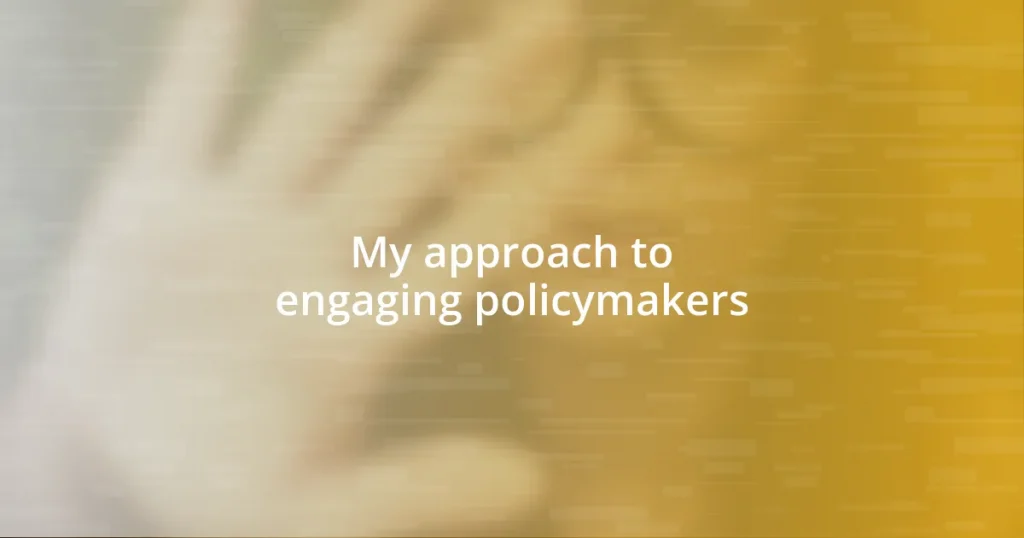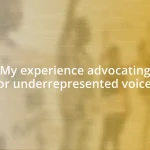Key takeaways:
- Define clear engagement goals aligned with policymakers’ interests to enhance advocacy effectiveness.
- Research policymaker interests and legislative history to tailor messages that resonate personally with them.
- Utilize effective outreach methods, such as leveraging personal connections and social media, to foster trust and engagement.
- Continuously measure engagement impact and adjust strategies based on feedback to improve future interactions.

Define engagement goals
Defining engagement goals requires a clear understanding of what you want to achieve with policymakers. For me, it often starts with asking, “What impact do I really want to make?” In my early days of advocacy, I remember sitting down with a mentor who emphasized that without defined goals, my efforts could easily scatter into frustration. That resonates deeply with me even now.
It’s essential to set both short-term and long-term objectives. When I first aimed to influence local environmental policies, I focused initially on raising awareness within my community. This clarity helped me identify specific events and platforms to target. Those smaller victories reinforced my commitment and gave me the energy to tackle bigger challenges down the line.
I can’t underestimate the importance of aligning engagement goals with the interests of the policymakers we’re trying to reach. Reflecting on my experiences, I’ve found success in framing my goals in ways that resonate with their priorities. For instance, presenting a compelling case about how a policy might benefit both the environment and the local economy creates a win-win scenario. Isn’t that the secret sauce to building a cooperative relationship?

Identify key policymakers
Identifying key policymakers is a crucial step in effective engagement. I often start my research by mapping out the political landscape, focusing on individuals with influence over specific issues. Once, while working on a community health initiative, I traced back funding decisions to a few key figures in local government. Understanding their roles and motivations allowed me to tailor my approach and made my outreach far more impactful.
In my experience, it’s also beneficial to dig deeper into the networks surrounding policymakers. Sometimes, the most profound influence comes from advisors, stakeholders, or even local activists who have established credibility. I recall a meeting where an ally introduced me to a policymaker’s aide who was genuinely passionate about health equity. That connection not only opened the door to direct communication but also offered invaluable insights about the policymaker’s priorities that I wouldn’t have been aware of otherwise.
Compiling this information can be streamlined with the right approach. I’ve found that creating a comparison table helps clarify which policymakers align best with my engagement goals. This visual aid keeps my focus sharp and ensures I don’t overlook any critical players.
| Criteria | Policymaker A | Policymaker B |
|---|---|---|
| Influence Level | High | Medium |
| Area of Focus | Health | Education |
| Past Engagements | Yes | No |
| Potential Allies | Non-Profit Organizations | Local Schools |

Research policymaker interests
Researching the interests of policymakers is where I find the magic beginning. Knowing what drives them helps shape my messages. For example, while preparing for a campaign on climate change, I discovered that a local representative had a keen interest in sustainable agriculture. By aligning my proposals with their passion, I could present solutions that felt personal and meaningful to them.
Here are some key areas I focus on when researching policymaker interests:
- Legislative History: Reviewing past bills they’ve supported indicates their priorities.
- Public Statements: Speeches and press releases often reveal their core beliefs and values.
- Social Media Activity: Following their posts can uncover current interests and community engagement.
- Committee Memberships: Understanding the committees they serve on sheds light on the issues they’re most committed to.
- Public Engagement: Attending town halls or public forums helps me gauge their focus areas directly from constituents.
This investigative approach has led to richer conversations. I recall a time when my dedicated research unearthed a policymaker’s passion for renewable energy. This insight allowed for a transformative dialogue that not only strengthened our rapport but also directly influenced project funding. The sense of connection I felt was profound, reaffirming how understanding interests can foster impactful collaborations.

Develop tailored communication strategies
Creating tailored communication strategies is essential for resonating with policymakers. In my experience, I’ve learned that messaging must reflect not only the content but also the context of the relationship. For instance, during a health advocacy campaign, I prioritized a more formal approach when communicating with a seasoned policymaker, while using a friendly and conversational tone with a younger representative who appreciated relatability. This adaptability proved invaluable in fostering a genuine dialogue.
Another effective strategy is to incorporate storytelling that aligns with the policymaker’s values. When advocating for mental health resources, I shared a personal story about a friend’s struggle and recovery. This narrative evoked empathy and made my argument more persuasive. Have you ever considered how stories can transform your data into something compelling? I find it often bridges the gap between statistics and human experience, making complex issues more accessible.
I can’t stress enough the importance of being concise and clear in my communication. Policymakers are often inundated with information, so I strive to distill my points into digestible formats. Recently, when presenting a funding proposal, I used visual aids like infographics instead of lengthy reports. The clarity they provided not only grabbed attention but also made it easier for them to grasp the core message quickly. Have you ever noticed how a simple chart can sometimes say more than a page of text?

Utilize effective outreach methods
Establishing effective outreach methods is crucial for engaging policymakers. One approach I’ve found particularly impactful is leveraging personal connections to reach out. Early in my career, I attended a networking event where a policymaker expressed concern about education funding. I took the initiative to follow up via email, sharing insights that reflected their interests, and this not only opened doors for further discussions but built a mutual trust that has lasted over time. Have you ever recognized how a single conversation can blossom into a robust professional relationship?
Social media also serves as a powerful tool for outreach. I regularly engage with policymakers through platforms like Twitter, where I share relevant articles or comment on their posts. For instance, when a local representative tweeted about housing reforms, I replied with a well-researched paper that highlighted the effects of homelessness on youth. This encouraged a dialogue that made my voice heard in a broader conversation. It’s fascinating how digital interactions can sometimes change the trajectory of policymaking discussions, isn’t it?
Finally, organizing community events can be an effective outreach method. I once organized a roundtable discussion on environmental policies, inviting both community members and local leaders. The informal setting encouraged open dialogue and provided policymakers with direct feedback on pressing issues. Through this experience, I felt a sense of fulfillment as our discussions led to tangible changes in local policy. Have you considered how fostering a space for shared dialogue can amplify your advocacy efforts significantly?

Measure engagement impact
One effective way I measure engagement impact is by tracking changes in policymaker attitudes and behaviors after my outreach efforts. For example, I once conducted a survey after presenting a proposal on renewable energy. The subsequent shift in a policymaker’s stance towards supporting green initiatives was not only encouraging but also revealed how critical my engagement had been. Have you ever paused to reflect on the subtle yet profound changes that can arise from a well-timed conversation?
I’ve also found that qualitative feedback often provides valuable insights into engagement impact. After a workshop I led on public health, a participant shared how the information changed her perspective on healthcare access. This anecdote emphasized that the real impact of my work isn’t just in data or statistics; it’s reflected in the conversations I have and the lives I touch. Isn’t it fascinating how one person’s story can illuminate the broader implications of our advocacy efforts?
To effectively gauge the long-term effectiveness of my engagement strategies, I revisit previous interactions and monitor the outcomes over time. I’d once followed up with a policymaker who initially opposed funding for mental health programs. Months later, I learned that they had championed an initiative in our community. Witnessing this transformation confirmed my belief that measuring the impact of engagement isn’t a one-off task—it’s an ongoing journey that evolves as relationships deepen. How often do you find yourself revisiting past conversations to assess their lasting effects?

Adjust strategies for improvement
Adjusting strategies for improvement is key to effectively engaging with policymakers. I remember a time when I realized my usual approach wasn’t resonating with certain lawmakers. After analyzing the situation, I tailored my strategies to align more closely with their priorities. This shift not only made our conversations more productive but also spotlighted how responsive I could be to their needs. Is there a specific moment when you needed to reassess your approach for better results?
Iterating based on feedback is also crucial. After hosting an event where I discussed youth programs, I asked attendees for their thoughts on the format and content. Their responses led me to tweak future presentations, focusing more on interactive elements that kept everyone engaged, particularly the policymakers. It’s incredible how such small adjustments can amplify the impact of our messages, isn’t it?
Lastly, experimentation can reveal unexpected pathways to improvement. I experimented with a multimedia approach, combining visuals and storytelling in a subsequent outreach campaign. This method captivated my audience, leading to deeper discussions on the issues at hand. Have you considered how breaking away from traditional formats could open new doors for dialogue and connection?















